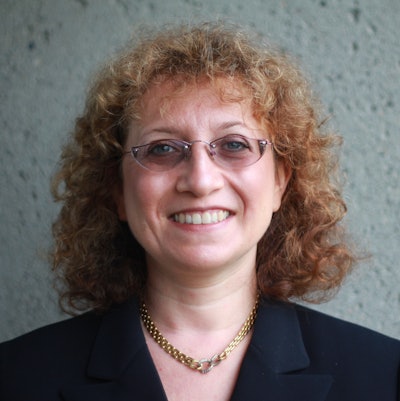As higher education works to navigate the pandemic, a new study notes that COVID-19 prevention strategies can be as effective as the new vaccines.
The study, co-authored by a multidisciplinary research team, including infectious disease clinicians, epidemiologists and biostatisticians, found that extensive distancing and mandatory mask-wearing alone can prevent 87% of campus COVID-19 infections and the cost is only $170 per infection prevented. Adding routine testing increases that cost substantially. While testing would increase prevention to between 92% to 96%, the cost per infection prevented would be between $2,000 to $17,000 each, depending on the frequency of testing.
 Dr. Elena Losina
Dr. Elena Losina“Routing testing at current prices is expensive,” said Dr. Elena Losina, the lead author of the report and director of the Policy and Innovation eValuations in Orthopedic Treatments Center. Losina also serves as co-director of Orthopedic and Arthritis Center for Outcomes Research at Brigham and Women’s Hospital and she serves as the Robert W. Lovett professor of orthopedic surgery at Harvard Medical School. “It could help to reduce infections further, but at greater cost.
“The solution to this is fast approval of inexpensive rapid tests that could be offered at much lower costs,” she added. “We hope that our work could expedite the production and use of inexpensive rapid screening tests that could be used in both private and publicly funded colleges and universities.”
Losina said that the analysis suggests in the absence of routine testing, rigorous implementation of and adherence to mask-wearing and social distancing protocols can lead to the prevention of the majority of COVID-19 cases on college campuses.
Individuals at a campus that has followed those protocols agree.
At Sacred Heart University in Connecticut, the contact tracing team found with those measures in place, there was no spread of COVID-19 in the classrooms.
“Clear, frequent and transparent communications were key to ensuring compliance to adhering to public health protocols,” said Dr. Sofia Pendley, a clinical assistant professor in the department of public health at Sacred Heart. “At the start of the semester, the university created a COVID-19 dashboard in a central location on the university’s homepage. The dashboard was updated daily with clear and easy to understand language and color-coded metrics.
“Frequent and creative communications were developed for social media with print placards placed around campus to serve as reminders,” she added. The university even constructed fragrant “scent tents” with flowers to remind students that loss of smell is a symptom of COVID-19.
The study also finds that that mask-wearing and social distancing outperforms closing a campus and switching to online-only education, which results in only a 63% reduction in infections.
“If no formal, clearly defined and regularly reinforced mitigation strategies are in place, such a scenario could lead to more congregation and less mask wearing among off-campus living students,” said Losina.
 Dr. Sofia Pendley
Dr. Sofia PendleyTo reach their results, the researchers examined 24 combinations of four common preventive strategies: mask-wearing, social distancing, testing and isolation and calculated their effectiveness and cost per infection prevented. The target population was undergraduate students and faculty at U.S. colleges and universities.
The data came from published literature. Researchers used a dynamic microsimulation model they called the Clinical and Economic Analysis of COVID-19 interventions (CEACOV) model, which examined alternative mitigation strategies. The CEACOV model tracks infections accrued by students and faculty, accounting for community transmissions over the course of one semester.
If no preventable measures are utilized, three out of every four students and approximately one out of six faculty members would become infected over the course of a semester. This raises the question about individuals who refuse to wear masks and social distance.
The analysis has gone through a rigorous peer review and has been published in Annals of Internal Medicine, a high-impact medical journal.
Losina said many colleges and universities required students to sign agreements outlining the commitment to follow strict mask-wearing and social distancing policies. These carried significant penalties, including suspension, for failure to comply.
Sacred Heart has implemented a blended learning structure and faculty have been trained in blended teaching pedagogy. In those classrooms being utilized, seats have been marked to ensure proper distancing. Faculty were given extra masks to hand out should a student need one.
“We hope that this report will help students to adhere to social distancing and masking policies instituted by their college administration,” said Losina. “It will help college leaders and administrators … tailor specific mitigation strategies to their budgets and structure. It will help speed up the development and wide implementation of inexpensive rapid tests.”



















